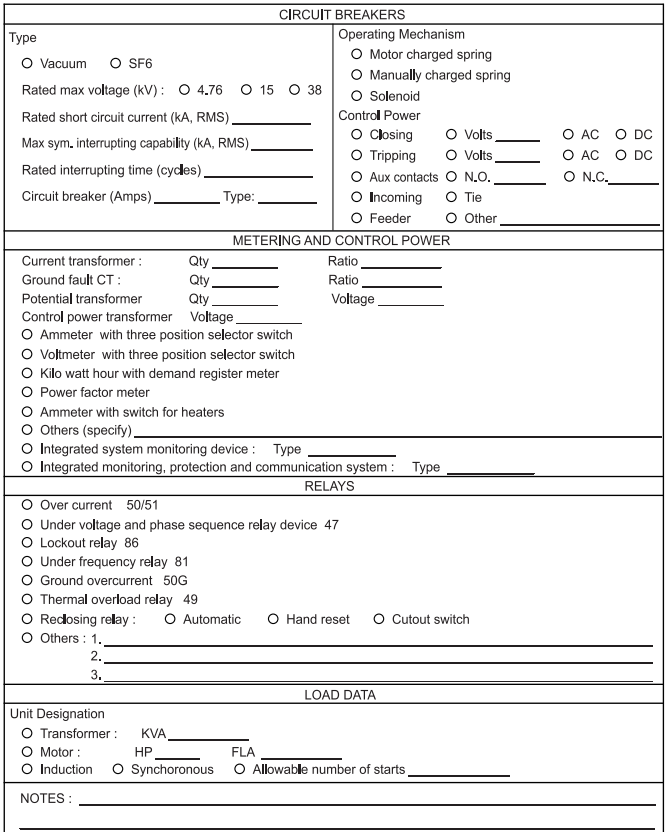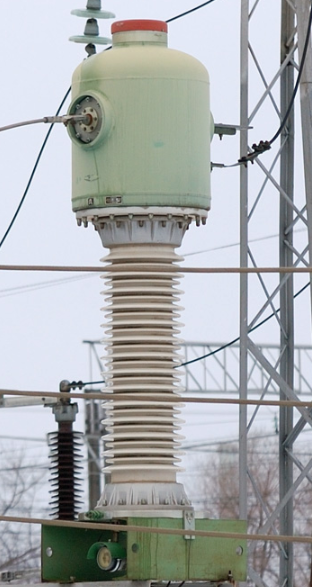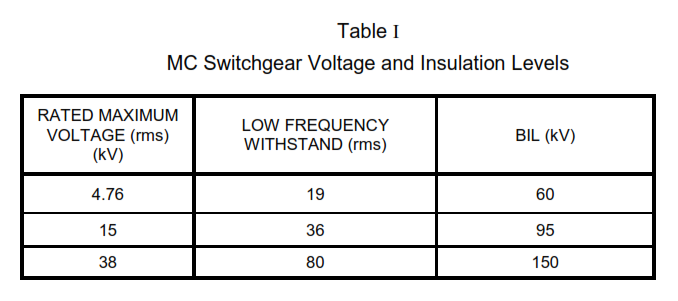This article is about general requirements for design, manufacture, testing and shipping of medium voltage, metal-clad, cubicle type, air-insulated and SF6 GAS switchgear. This equipment is for installation indoors in an unclassified area. Main keywords for this article are Switchgear Inspection and Testing, Basic Impulse Insulation Level, SF6 Gas Circuit Breakers, Metal-Clad Switchgear, NEC Medium Voltage Switchgear Design
References
National Fire Protection Association (NFPA)
NEC (NFPA 70) National Electrical Code
American National Standards Institute / Institute of Electrical and Electronic Engineers (ANSI/IEEE)
C37.09 Test Procedure for AC High Voltage Circuit Breakers
C37.20.2 Metal Clad and Cubicle Switchgear
C57.13 Requirements for Instrument Transformer
Definitions
For the purpose of understanding this article, the following definitions apply.
Auxiliary Compartment. The portion of the switchgear assembly assigned for housing auxiliary equipment, for example potential transformers, control power transformers, or other miscellaneous devices.
Circuit Breaker. A device capable of opening and closing the power line feeder to an electrical system manually or automatically. It opens the circuit automatically at predetermined values of overcurrent or fault current by circuit protection relays, without damage to the mechanism or the current-carrying portion of the device. The basic function of this device is to open or close the circuit under normal and abnormal conditions.
Ground and Test Device. A term applied to a switchgear assembly accessory device which can be inserted in place of a drawout circuit breaker for the purpose of (1) grounding the main bus and external circuits connected to the switchgear assembly and (2) primary circuit testing.
Instrument Transformers. Instrument transformers provide power to protective relays in low voltage systems, and are of two types: voltage transformers for use in voltage measurement, and current transformers for use in current measurement. These transformers have two primary functions. Firstly, they serve to reduce the large value of rated primary circuit voltages and current encountered in modern power circuits to a common secondary base, thus permitting standardization of meters, relays or other measuring devices. These secondary values are usually 120 V and 5 A. Secondly, they provide insulation between primary and secondary circuits, thus protecting meters and devices from dangerously high voltages.
Continuous Current Rating. The rated current of metal-enclosed switchgear is the maximum current in rms amperes at rated frequency which can be carried continuously by the primary circuit components, including buses and connections.
Rated Maximum Voltage. The rated maximum voltage of metal-enclosed switchgear is the highest rms voltage for which the equipment is designed, and is the upper limit of operation.
SF6 Gas. Sulfur hexaflouride gas exhibits excellent dielectric strength and high arc extinguishing characteristics to its low thermal constant. Its high free electron absorption and chemical stability allows a rapid recombination of the products from the action of the arc.
Stored-Energy Operation. Circuit breaker operation by means of energy stored in the mechanism itself prior to the completion of the operation, and sufficient to complete it under predetermined conditions.
Switchgear. A general term for a design which includes all the equipment required to control an individual circuit. This interrupting device, in combination with the associated controls and metering, provides protection to the cables and equipment. It is primarily used in distribution of electric power for various voltage levels.
NEC Medium Voltage Switchgear Design Requirement
Switchgear designed for plant facilities shall meet the requirements of ANSI/IEEE C37.20.2.
Switchgear Ratings
Voltage Ratings – The rated maximum voltage shall be 5, 15 and 38 kV as specified in below data sheet .
Frequency Rating – Rated voltage and current for switchgear shall be based on 60 Hz.
Rated Short-Time Current – The rated short time current of the metal-enclosed switchgear is the average rms current thatit shall carry for a period of 2s.
https://paktechpoint.com/what-is-switchgear-paktechpoint/
Metal-Clad Switchgear
- Live parts shall be completely enclosed within grounded metal enclosures.
- The secondary control devices and wiring shall be isolated from the high voltage primary devices by grounded metal barriers, except for certain runs of the secondary wiring where barriers are impractical.
- Circuit breakers shall be removable, equipped with self coupling primary and secondary disconnecting contacts, and arranged with the disconnecting means to physically move between the connected and disconnected positions.
- Major primary circuit components, for example circuit breakers, load break switches and buses shall be isolated by grounded metal barriers.
- Buses, joints and connections shall be insulated throughout the equipment.
- Interlocking shall be provided, for correct sequential operation.
Metal-Clad Switchgear Application
The metal-clad switchgear assembly shall conform to ANSI C37.20.2 and shall include drawout type circuit breaker assemblies, buses, fuses and other protective devices, controls, metering and instrumentation.
Metal-Clad Switchgear Construction
The switchgear vertical sections shall be NEMA, free standing, factory assembled, 3.2 mm thick steel construction, with doors and access panels of sufficient size to give full access to all components. Adjacent vertical sections and individual compartments shall be isolated from each other by means of sheet steel barriers. The vertical sections shall be bolted together into an enclosed dead-front assembly mounted on an integral base frame. Vertical sections of the switchgear assembly shall share a common horizontal main bus and a common ground bus running the length of the switchgear line up. The switchgear shall not be configured in a back to back arrangement.
- Vertical Sections
Each vertical section shall comprise an upper and lower compartment. The lower compartment shall usually contain the main switching device (circuit breaker). The upper compartment shall contain the protective devices, controls, metering and instrumentation; effectively isolated from the lower compartment by horizontal full width metal barriers. Cable raceways shall maintain individual circuit integrity. - Future Expansion
A ‘spare’ switchgear shall be arranged for future expansion, and the enclosures shall be of modular design to permit safe and easy installation of additional units. These units shall include, but not be limited to, such items as predrilled buses, terminal blocks for secondary wiring, and removable enclosure end covers secured by captive hardware on the structure. Enclosure for the future shall be completely equipped to contain breaker stabs, current transformers, bus bars, wiring, test block, relays and circuit breaker to make an operating feeder, as specified on the one line diagram. - Space Locations
A space location shall be a complete vertical section and shall be similar to a ‘spare’ except that the main circuit breaker shall not be installed. There shall be a minimum of one ‘spare’ and ‘space’ location connected to every bus as specified on the one line diagram.
Circuit Breakers
Circuit breakers shall be 3 pole drawout, vacuum or SF6 interrupter type, rated for a nominal interrupting and close latching current rating as specified in data sheet.
Vacuum Circuit Breakers
- The vacuum circuit breakers shall be three pole, single throw, mechanically and electrically trip free.
- Breakers shall be equipped with position indicator, operation counter, primary and secondary disconnecting devices, auxiliary switches and required mechanical safety interlocks.
- Breakers shall be equipped with a stored energy operator.
SF6 Gas Circuit Breakers
- Circuit breakers shall be single-pressure, puffer type with one interrupter per phase.
- Circuit breakers shall be installed horizontally, with adequate access to arc chambers and contacts.
- Breakers shall be equipped with a stored energy operator.
- Alarms for indicating insufficient gas density in the circuit breaker shall be provided.
Breaker Interlocks
Mechanical interlocks shall be provided to make it impossible for a closed circuit breaker to be withdrawn from, or inserted into, the connected position. It shall not be possible to operate a circuit breaker when it is between the connected and test positions. A mechanical device shall be provided to release the energy stored in the closing springs before a circuit breaker is removed from the cubicle.
Breaker Padlocking
Provision for padlocking circuit breakers in the test or disconnected position shall be provided. Padlocking shall not interfere with the operation of the breaker or its mechanism. When padlocked in the disconnected position, the breaker shall either be not removable from the compartment, or, the access to the racking mechanism shall be effectively prohibited by the padlock.
Dead-Front Construction
Circuit breakers shall be dead-front construction, equipped with an integral steel-front panel. Operating controls and indicators shall include a trip button or close button, open/close indicator, spring charge/discharge indicator, and operations counter. The open/closed indicator shall be visible from the front of the equipment (outer door open) when the breaker is in the operating or disconnected/test position.
Breaker Operating Mechanism
Each circuit breaker shall have a stored-energy type operating mechanism with a spring charging motor. The shunt trip coil shall operate on direct current (dc), with the voltage rating specified in date sheet. Each circuit breaker shall be electrically and mechanically trip-free. The closing circuit shall be arranged to preclude repetitive operation during fault conditions if the circuit breaker control switch is held in the close position. Upon loss of control power, it shall be possible to manually recharge the stored energy mechanism by use of a single ratchet wrench or operating lever.
Breaker Remote Control
Where breaker remote control function capability is specified, the breaker door-mounted control switch close position shall function as a ‘permissive only’ switch for remote control functions when the breaker is in the connected position. When the breaker is installed in the test position, the local control switch ‘trip’ and ‘close’ functions shall be operable. The trip function of the local control switch shall operate in either the test or connected position. The remote control functions shall be disabled when the breaker is in the test or disconnected position.
Breaker Auxiliary Contacts
Circuit breakers shall be equipped with auxiliary contacts for interlocking with control circuits, indicating lights and auxiliary relays. Auxiliary switches in the breaker and instrument compartment shall be breaker-operated as follows:
a. Each breaker shall be equipped with at least 2 N.O. and 2 N.C. electrically separate breaker auxiliary contacts operated by the breaker and wired from the breaker to terminal blocks
b. Each breaker compartment shall be equipped with a minimum of 3 N.O. and 3 N.C. electrically separate mechanism-operated type (MOC) auxiliary switch contacts. These contacts shall operate only in the connected and test positions.
c. A stationary truck-operated cell switch (TOC) shall be furnished for all circuit breaker compartments. The contacts shall operate when the breaker is moved from the connected to the test position. A minimum of 3 N.O. and 3 N.C. contacts shall be included.
Interchangeability
Circuit breakers of the same rating shall be interchangeable and interlocked with the breaker cubicle to prevent insertion of a breaker with a lower continuous or interrupting rating into a
higher rated compartment.
Switchgear Main Bus
Main Bus Ratings
- The continuous current rating of the main bus shall match that of the protective devices.
- The main bus shall be designed and rated for the full ampere capacity specified, and shall not be tapered for the purpose of reducing current densities.
- The main bus shall be copper with silver plated joints, and shall have epoxy, flame-retardant and track-resistant insulation. The main bus supports between units shall be flame-retardant, track-resistant, glass polyester for 5-and 15-kV class. The main bus supports for 38-kV class shall be made of cycloaliphatic epoxy. The switchgear shall be constructed so that all buses, bus supports and connections shall withstand stresses produced by currents equal to the momentary ratings of the circuit breakers. A set of either 1200-, 2000- or 3000- ampere insulated copper main buses shall be provided, which shall have provisions for future extension. Bus joints shall be plated, bolted and insulated with easily installed boots. The bus shall be braced to withstand fault currents equal to the close and latch rating of the breakers. The temperature rise of the bus and connections shall be in accordance with ANSI C37.20.2, and documented by design tests.
- The main bus shall extend the full length of the assembly and shall be drilled at both ends for the addition of splice plates to extend the bus in either direction for future expansion.
Switchgear Ground Bus
A 6.35 mm by 50.8 mm (minimum) copper ground bus shall be provided over the entire length of the assembly, with provisions for extensions at either end for future expansion. Provisions shall also be made to terminate a 120 mm2 copper ground-system cable at each end. The ground bus shall be routed at the rear of the assembly.
Potential Transformers (PT)
- For working principle of potential transformer please Click Here.
- Potential transformers shall be provided as required, to power instruments, metering, and relaying, as shown on the single line diagram specific to the switchgear. The manufacturer of the equipment shall be responsible for checking that burdens comply with ANSI C57.13.
- The Basic Impulse Insulation Level (BIL) shall be coordinated with that of the switchgear. Potential transformers shall be drawout type, with primary side current limiting fuse protection, and secondary fuse protection, if required from the single line diagram and data sheets. The transformer tray shall be equipped with a position switch to prevent tripping of the protective device when the potential transformers are withdrawn.
- An interlock shall be furnished so that transformer primary fuses cannot be withdrawn until the transformer secondary breaker switch is opened.
- Minimum wire size for the potential transformer secondary circuit shall be 2.5 mm2 (14 AWG) stranded copper, 600 V, rated at 90 qC or greater.
Current Transformers (CT)
- For working principle of potential transformer please Click Here.
- Current transformers shall be provided in the application of instruments, meters, and relaying as shown on the single line diagram specific to the switchgear. The manufacturer of the equipment shall be responsible for checking burdens to be in compliance with ANSI C57.13, and the BIL shall be coordinated with that of the switchgear.
- The current transformers shall be insulated for the full voltage rating of the switchgear, and shall be mechanically rated to withstand the maximum short circuit momentary rating of the switchgear.
- The primary CT current rating shall be the nearest standard rating equal to not less than 125 percent of the normal primary current in the circuit.
- CT’s may be of wound-type or through-type construction.
- Minimum wire size for current transformer secondary circuits shall be 2.5 mm2 (14 AWG) stranded copper, 600 V, rated at 90 °C or greater.
- When required by the specification, shorting links shall be provided on the CT’s terminal block.
Safety Devices
It is critical to limit personnel exposure to shock hazard and the results of internal faults within the switchgear. For these reasons the following general guidelines shall be followed in specifying safety features to be incorporated into the metal-clad switchgear:
a. Positive mechanical interlocks
b. Complete protection shall be provided against contact with live parts
c. The circuit breaker trucks shall be fully integrated into the interlock system
d. Partitions and barriers shall be provided where required, to prevent the spread of faultse. The enclosures shall have been arc-fault tested, and be capable of withstanding the maximum internal pressure that may be generated by a fault in the switchgear
f. Circuit breakers shall be capable of being line tested while still being inserted
Auxiliary Compartment
- The auxiliary compartment shall be sheet steel enclosures similar to circuit breaker cells, but without provisions for the circuit breaker. They shall be used to house voltage and control power transformers, fuses and other auxiliary devices. Drawout trays may be included for the mounting of the transformers. The front door panel of the auxiliary compartment may be used to mount meters, switches, alarm relays to the annunciator panel, or other types of instrumentation.
Basic Impulse Insulation Level (BIL)
BIL is the amount of high magnitude, short duration overvoltage that the switchgear insulation can tolerate without breaking down. To simplify design and application, the values in Table I have been established, which are in conformance with ANSI C37.20.2 Table I.
Switchgear Inspection and Testing
Switchgear assemblies and circuit breakers shall be tested and inspected at the factory as part of the regular manufacturing process. Factory testing and inspection shall conform to ANSI/IEEE C37.09 paragraph 5 and C37.20.2 paragraph 5.3. The manufacturer shall provide SABIC with test results. Following test normally to be checked
a. High potential tests of primary circuits and secondary wiring
b. Relay and metering circuits shall be energized and devices checked, to ensure that polarities are correct, elements are in operating condition, and relays are performing the desired function
c. No-load operational tests of circuit breakers shall be performed at maximum, standard, and minimum control voltage ratings
d. Operation of mechanical interlocks and breaker interchangeability
e. Confirmation of proper function of the sequential interlocks
f. Dielectric tests
g. Size and rating of each type of equipment, compared to the requirements of the purchase order
h. Factory setting of contact gap
i. Insulation resistance test




